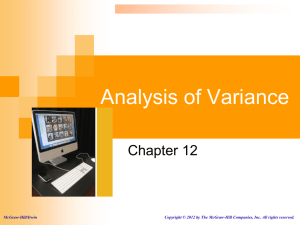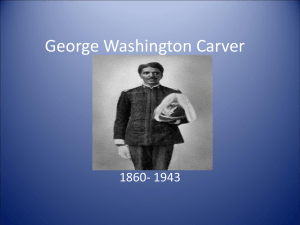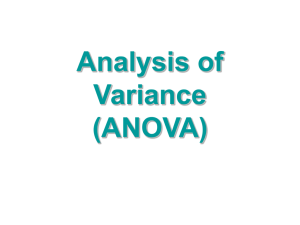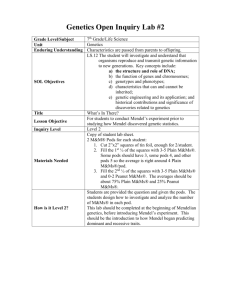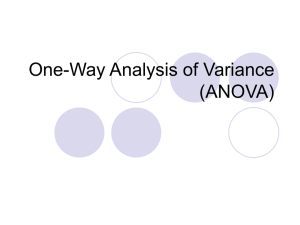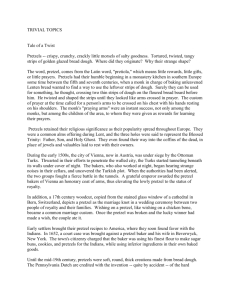Presentation Slides
advertisement
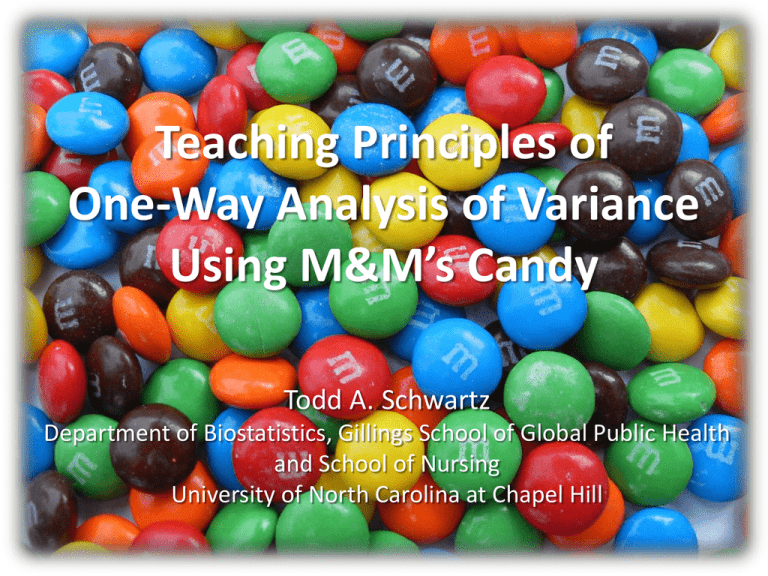
Teaching Principles of One-Way Analysis of Variance Using M&M’s Candy Todd A. Schwartz Department of Biostatistics, Gillings School of Global Public Health and School of Nursing University of North Carolina at Chapel Hill M&M’s in the Statistics Classroom • Used to illustrate a variety of topics – – – – – – frequencies and proportions probability functions sampling distributions design of experiments chi-square goodness-of-fit statistics correlation/linear regression • Advantages – – – – – – – edible reward at the conclusion of the experiment intuitive basis on which instructors can build fun activities active learning reducing students’ anxiety enhancing student engagement and learning follows recommendations of the GAISE College Report M&M’s in the Statistics Classroom • Straightforward illustration of one-way ANOVA • Discussion of many relevant considerations • Instructor may not know a priori what the results will yield • Several alternative response variables for analysis – likely to provide a variety of scenarios from which the instructor may select • classroom demonstrations • homework exercises • examination questions Context • 12 to 15 students • Doctoral-level nursing program • Easily adaptable – undergraduate students – various disciplines – variety of classrooms Materials • Classroom computer – spreadsheet software (e.g., Excel) – statistical software – projected onto a screen in the classroom • Classroom configured to allow the students to align themselves into pre-assigned groups – students do not need access to individual computers during this exercise • These students have had previous, introductory exposure to one-way ANOVA – demonstration also suitable for novice students without any prior ANOVA experience Materials • Sequencing – exercise occurs after two-independent group t-tests – need for an extension to those methods for comparing more than 2 groups • Discussion – the types of research questions that ANOVA can address – issues of within- and between-group variability – influence of sample size Materials • Preparation – minimal – create student groupings • approximately one-third of the total class size – each group will receive only one type of M&M’s (e.g., peanut M&M’s) – each member of the group receives his or her own packet of that type of M&M’s Materials • Unpopulated spreadsheet – record the data from the students in real-time – gives the students experience in how to structure their primary data collection – facilitate analysis after the data are collected – first column • each student’s name in a separate row, grouped according to their assignment (ID) – second column • group assignment (independent variable) Materials Materials • Prepare M&M’s for distribution – choose three different varieties of M&M’s • could easily extend to more than three types – Plain (milk chocolate in a brown wrapper) – Peanut (yellow wrapper) – many more varieties on store shelves • • • • • Peanut Butter Coconut Dark Chocolate Pretzel Almond • Goal: have roughly the same colors represented across all types of M&M’s Materials • Cost will vary – retail price per packet is approximately $1.20 – achieve cost savings • store promotions • buying in bulk • Packets for all types should all be approximately the same size or weight – invokes variability among the types due to the varying sizes of the individual M&Ms • a single milk chocolate M&M is smaller (and weighs less) than its peanut M&M counterpart Materials • I tend to choose two of the types to have individual candies of similar size; 3rd substantially different – e.g., peanut and pretzel M&M’s are similarly sized; both substantially larger than milk chocolate M&M’s • Facilitates illustrations of varying patterns of statistically significant findings that are intuitive – despite potentially small sample sizes Methods • Start in-class demonstration by announcing the groupings of the students • Rearrange themselves into their groups • Distribute the corresponding packets of M&M’s to each group • Caution them not to “eat the data” until the conclusion of the demonstration – their interest is piqued – “breaks the ice” – lowers their guard (anxiety) so learning can occur Methods • Research question: “Do different types of M&M’s have a different number of candies inside similarly-sized packages?” – question may be repeated for each color under consideration – 6 traditional colors of M&Ms are red, green, blue, yellow, orange, and brown • Context: want to know which type to purchase at the store in order to maximize the total number of M&M’s (or the number of a certain favorite color) Methods • Instruct the students (individually) to count the total number of M&M’s in their packets – sort them by color and to count the number of each color. • Give the students a few minutes to complete this task and to record their numbers • Project the unpopulated spreadsheet onto the classroom screen – discuss the structure of how we will record the data and organize it for analysis – rows for observations, columns for variables Methods • At this point, I can present a brief review of key concepts of one-way ANOVA – overall null hypothesis of testing all group population means equal to one another – how that specifically relates to our data • Based on intuition, students can guess whether the null hypotheses will be supported or rejected for the data – provide the rationale for their responses Methods • Identify important concepts to the dataset – identifying the dependent and independent variables – how they are represented in the spreadsheet • Populate the spreadsheet – call on the students in the order their names appear in the spreadsheet – each student will then orally recite his or her data values in the order of the columns of the spreadsheet – I have the final column pre-programmed to sum across the color subtotals to verify that the student’s total matches the sum of the color subtotals • lesson on data integrity • easier to take precautions to detect data errors as they are entered Methods • When spreadsheet is completely populated – save the spreadsheet file – make it available to the class • course management system • email attachment • Primary source dataset – students have been involved from beginning to end – seven different potential one-way ANOVAs • one for the mean total number • one for the mean of each color’s subtotal • Useful for – – – – in-class demonstration subsequent assignments projects examinations Methods Results (1 replication of exercise) • Also teaching students to use statistical software • Preliminary analyses separately for each type of M&M’s – computation of univariate statistics • means and standard deviations – information on the distributions • e.g., through boxplots • Tie together numerical results with visual impact of plots Table Selected descriptive statistics for the subtotal of brown M&M’s GROUP Plain Peanut Pretzel N 4 4 4 Mean 5.5 2.8 1.5 Std Dev 1.7 1.0 1.3 Minimum Maximum 4.0 8.0 2.0 4.0 0.0 3.0 Results Results • Inferential statistics • Can review the two-sample t-test – compare and contrast results from those two approaches – generalize the one-way ANOVA from k=2 groups to k=3 groups – motivate the advantages of analyzing all of the groups in a single analysis, rather than as pairs through separate ttests • Depending on the nature of the course, different aspects of the ANOVA may be emphasized Results • For my students, I focus on the – ANOVA (sums of squares) table – parameter estimates (especially their interpretations; data not shown) – least squares group means • how these values are exactly the same as the descriptive statistics (means) – formal testing of each of the pairwise comparisons Table ANOVA table for the mean subtotal of brown M&M’s Source DF Sum of Squares Mean Square Model 2 33.50 16.75 Error 9 16.75 1.86 Corrected Total 11 50.25 F Value 9.00 Pr > F 0.0071 Results • Issue of multiple comparisons – some of the more commonly used methods, with their advantages – Bonferroni, Tukey, etc • Below, the Bonferroni approach provides p>.05 for the comparison of Plain vs. Peanut, while the Tukey approach yields p<.05. • Discussion of strategically selecting the multiple comparisons technique a priori – depending on study objectives Bonferroni-adjusted pairwise comparisons for testing row versus column means (subtotal of brown M&M’s) Row/Column Plain Peanut Pretzel Plain 0.0572 0.0075 Peanut 0.0572 0.6819 Pretzel 0.0075 0.6819 Tukey-adjusted pairwise comparisons for testing row versus column means (subtotal of brown M&M’s) Row/Column Plain Peanut Pretzel Plain 0.0456 0.0063 Peanut 0.0456 0.4321 Pretzel 0.0063 0.4321 Results • 7 different possible ANOVAs – interesting configurations inevitably arise • one color might provide a significant p-value for the overall null hypothesis, with a mixture of significant and nonsignificant pairwise differences • Another color might give a counter-intuitive pattern of a significant p-value for the overall null hypothesis , with all pairwise differences being nonsignificant • yet another color might lead to the scenario of a nonsignificant pvalue for the overall null hypothesis, but one or more significant pairwise differences – discussion of such paradoxical findings – my choice of having at least one of the types to be significantly smaller or larger than the others • facilitates the existence of interesting findings in at least one of the ANOVAs • I do not know a priori what the findings will be Discussion • Demonstration need not be conducted in a computer lab – nor do the students need to have access to their own computers during the demonstration • Can also discuss a myriad of considerations – – – – – – – – – – – – issues of random assignment to groups within- versus between-person factors effect size within- and between-group variability equal versus unequal group sample sizes sample size and power considerations importance of preliminary descriptive analysis to confirm or debunk investigators’ intuition difference between the hypothesis of equality of all group means versus pairwise comparisons multiple comparisons understanding of the various components of the software output proper interpretation of computer output appropriate reporting of findings Discussion • At the conclusion of the exercise – can generalize the one-way ANOVA from k=3 groups to an unspecified number of groups – to help the students crystallize their thinking, can ask students to describe how this experiment could be repeated with k=4 or k=5 • by adding additional types of M&M’s • Later in the course, I can illustrate one-way ANCOVA – examining one of the color subtotals, while covariate adjusting for the total counts – More focused research question for each color – “Do different types of M&M’s have a different number of candies of a specific color when the total number in the packages is the same?” • After two-way ANOVA – can reinforce concepts by asking how we might have extended the M&M’s experiment to include a second factor • e.g, repeating the process with a different sized bag of each type Discussion • Limitation – subject matter of M&M’s does not naturally translate to the subject matter of interest to the students – can be offset by having the instructor explicitly bridge the gap from the foundational knowledge built using the M&M’s to variables that would be relevant to the students’ area of study • useful examination question: contextualize the material • ask students to express a dependent variable matched with an independent factor that would be relevant to their particular field of interest • ensures the students are engaging with the material at an appropriate level Discussion • Another drawback – this exercise does not easily provide a rationale for the use of random assignment as might be expected in an experimental design context – allows for that discussion • randomization is not always possible for ethical or other reasons • quasi-experimental or observational designs Discussion • Larger classes – costs will increase directly with class size – logistics of data collection • could be reduced by segmenting a large class into smaller sections of the classroom – benefit: increased sample size • Anecdotal evidence that this exercise conveys the relevant concepts in a lasting fashion – former student commented that during her dissertation research, she would return to our example and ask herself how elements of her dissertation dataset translated to the M&M’s demonstration! Discussion • Overall, this exercise has proven to be a useful, fun, and memorable learning tool • In-class demonstration can easily be completed in one hour or less, or it can span more than one class period – depending on the depth of coverage desired by the instructor • Out-of-class preparation – not time- or labor-intensive – relatively inexpensive Questions?

